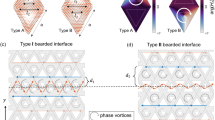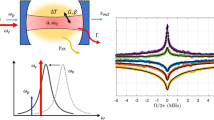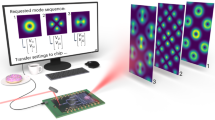Abstract
Storing light on-chip, which requires that the speed of light be significantly slowed down, is crucial for enabling photonic circuits on-chip. Ultraslow propagation1,2,3 and even stopping4,5 of light have been demonstrated using the electromagnetically induced transparency effect in atomic systems1,3,4,5 and the coherent population oscillation effect in solid-state systems2. The wavelengths and bandwidths of light in such devices are tightly constrained by the property of the material absorption lines, which limits their application in information technologies. Various slow-light devices based on photonic structures have also been demonstrated6,7,8,9,10; however, these devices suffer a fundamental trade-off between the transmission bandwidth and the optical delay. It has been shown theoretically11,12,13 that stopping light on-chip and thereby breaking the fundamental link between the delay and the bandwidth can be achieved by ultrafast tuning of photonic structures. Using this mechanism, here we report the first demonstration of storing light using photonic structures on-chip, with storage times longer than the bandwidth-determined photon lifetime of the static device. The release time of the pulse is externally controlled.
This is a preview of subscription content, access via your institution
Access options
Subscribe to this journal
Receive 12 print issues and online access
$259.00 per year
only $21.58 per issue
Buy this article
- Purchase on SpringerLink
- Instant access to full article PDF
Prices may be subject to local taxes which are calculated during checkout




Similar content being viewed by others
References
Hau, L. V., Harris, S. E., Dutton, Z. & Behroozi, C. H. Light speed reduction to 17 metres per second in an ultracold atomic gas. Nature 397, 594–598 (1999).
Bigelow, M. S., Lepeshkin, N. N. & Boyd, R. W. Superluminal and slow light propagation in a room-temperature solid. Science 301, 200–202 (2003).
Ghosh, S., Sharping, J. E., Ouzounov, D. G. & Gaeta, A. L. Resonant optical interactions with molecules confined in photonic band-gap fibers. Phys. Rev. Lett. 94, 093902 (2005).
Liu, C., Dutton, Z., Behroozi, C. H. & Hau, L. V. Observation of coherent optical information storage in an atomic medium using halted light pulses. Nature 409, 490–493 (2001).
Phillips, D. F., Fleischhauer, A., Mair, A., Walsworth, R. L. & Lukin, M. D. Storage of light in atomic vapor. Phys. Rev. Lett. 86, 783–786 (2001).
Vlasov, Y. A., O’Boyle, M., Hamann, H. F. & McNab, S. J. Active control of slow light on a chip with photonic crystal waveguides. Nature 438, 65–69 (2005).
Gersen, H. et al. Real-space observation of ultraslow light in photonic crystal waveguides. Phys. Rev. Lett. 94, 073903 (2005).
Poon, J. K., Zhu, L., DeRose, G. A. & Yariv, A. Transmission and group delay of microring coupled-resonator optical waveguides. Opt. Lett. 31, 456–458 (2006).
Xu, Q. et al. Experimental realization of an on-chip all-optical analogue to electromagnetically induced transparency. Phys. Rev. Lett. 96, 123901 (2006).
Xu, Q., Shakya, J. & Lipson, M. Direct measurement of tunable optical delays on chip analogue to electromagnetically induced transparency. Opt. Express 14, 6463–6468 (2006).
Yanik, M. F., Suh, W., Wang, Z. & Fan, S. Stopping light in a waveguide with an all-optical analogue of electromagnetically induced transparency. Phys. Rev. Lett. 93, 233903 (2004).
Yanik, M. F. & Fan, S. Stopping light all-optically. Phys. Rev. Lett. 92, 083901 (2004).
Yanik, M. F. & Fan, S. Stopping and storing light coherently. Phys. Rev. A 71, 013803 (2005).
Chu, S. T., Little, B. E., Pan, W., Kaneko, T. & Kokebun, Y. Second-order filter response from parallel coupled glass microring resonators. IEEE Photon. Technol. Lett. 11, 1426–1428 (1999).
Matsko, A. B., Savchenkov, A. A., Strekalov, D., Ilchenko, V. S. & Maleki, L. Interference effects in lossy resonator chains. J. Mod. Opt. 51, 2515–2522 (2004).
Emelett, S. & Soref, R. Analysis of dual-microring-resonator cross-connect switches and modulators. Opt. Express 13, 7840–7853 (2005).
Almeida, V. R., Barrios, C. A., Panepucci, R. R. & Lipson, M. All-optical control of light on a silicon chip. Nature 431, 1081–1084 (2004).
Almeida, V. R. et al. All-optical switching on a silicon chip. Opt. Lett. 29, 2867–2869 (2004).
Xu, Q., Schmidt, B., Pradhan, S. & Lipson, M. Micrometre-scale silicon electro-optic modulator. Nature 435, 325–327 (2005).
Soref, R. A. & Bennett, B. R. Electrooptical effects in silicon. IEEE J. Quantum Electron. 23, 123–129 (1987).
Borselli, M., Johnson, T. J. & Painter, O. Measuring the role of surface chemistry in silicon microphotonics. App. Phys. Lett. 88, 131114 (2006).
Preble, S. F., Xu, Q., Schmidt, B. S. & Lipson, M. Ultrafast all-optical modulation on a silicon chip. Opt. Lett. 30, 2891–2893 (2005).
Notomi, M. & Mitsugi, S. Wavelength conversion via dynamic refractive index tuning of a cavity. Phys. Rev. A 73, 051803 (2006).
Gaburro, Z. et al. Photon energy lifter. Opt. Express 14, 7270–7278 (2006).
Borselli, M. High-Q Microresonators as Lasing Elements for Silicon Photonics. Thesis, California Institute of Technology, Pasadena (2006).
Almeida, V. R., Panepucci, R. R. & Lipson, M. Nanotaper for compact mode conversion. Opt. Lett. 28, 1302–1304 (2003).
Acknowledgements
The authors thank S. Fan of Stanford University for fruitful discussions. This work was carried out in part at the Cornell Nano-Scale Science & Technology Facility (CNF) and the Cornell Center for Nanoscale Systems (CNS).
Author information
Authors and Affiliations
Corresponding author
Ethics declarations
Competing interests
The authors declare no competing financial interests.
Rights and permissions
About this article
Cite this article
Xu, Q., Dong, P. & Lipson, M. Breaking the delay-bandwidth limit in a photonic structure. Nature Phys 3, 406–410 (2007). https://doi.org/10.1038/nphys600
Received:
Accepted:
Published:
Issue date:
DOI: https://doi.org/10.1038/nphys600
This article is cited by
-
Controlled-phase gate by dynamic coupling of photons to a two-level emitter
npj Quantum Information (2022)
-
Temporal loss boundary engineered photonic cavity
Nature Communications (2021)
-
Front-induced transitions control THz waves
Communications Physics (2021)
-
Thermo-optically induced transparency on a photonic chip
Light: Science & Applications (2021)
-
Dynamic dissipative synchronized cooling of two mechanical resonators in strong coupling optomechanics
Quantum Information Processing (2021)



